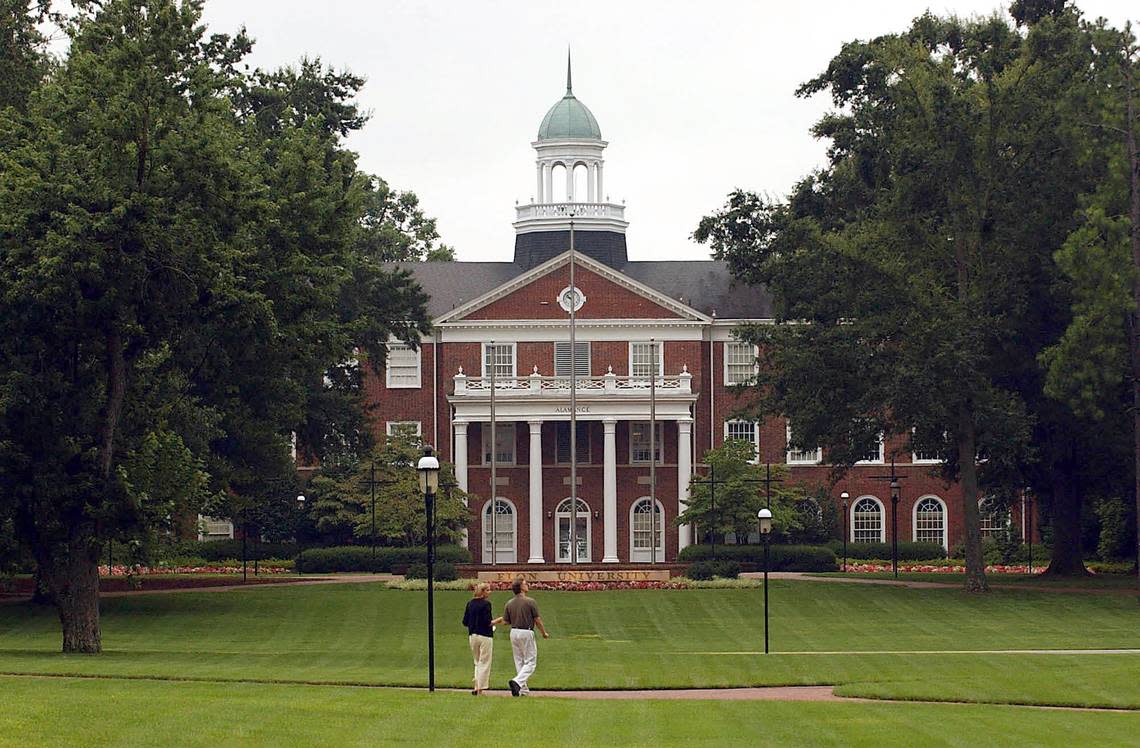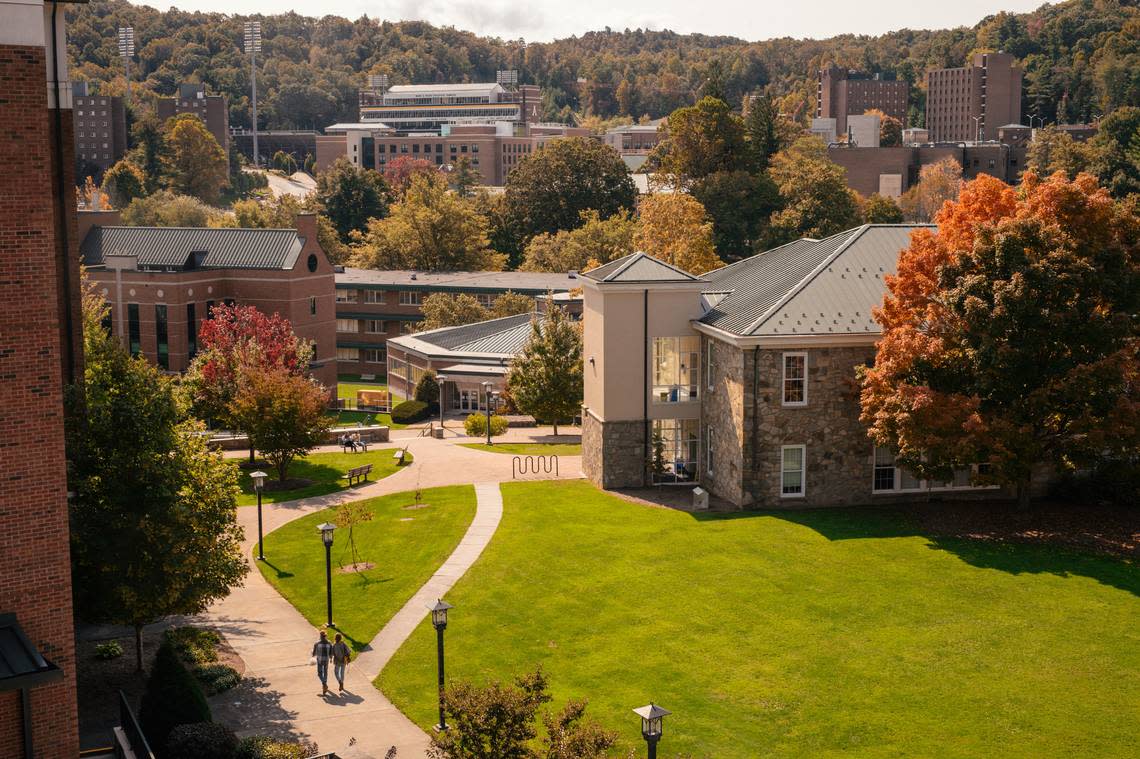NC schools make Forbes’ Top Colleges of 2022 list (one’s in a top-10 spot)
Eleven North Carolina universities made Forbes’ Top Colleges of 2022 list, featuring 500 schools to “showcase the finest in American education,” Forbes wrote.
Each school listed also includes:
The average amount of grant aid students receive (which can include institutional grant aid, as well as state, local and federal grant aid, per Forbes).
The average amount of loan debt students have upon graduation.
The median salary graduates earn 10 years after graduation.
Duke University made the top-10 list, while UNC-Chapel Hill and Wake Forest University made the top 50.
For the full list, visit forbes.com/top-colleges.
Here’s how all North Carolina colleges ranked:
No. 9: Duke University
Students at the private, not-for-profit university, on average, receive $50,914 in grant aid and graduate with $8,494 in loan debt. Ten years after graduation, graduates earn a median of $155,000.
“Duke offers 53 undergraduate majors at its Durham, NC, campus, including top programs in computer science, economics and public policy. Its student newspaper, The Chronicle, has been publishing since 1905,” Forbes wrote.
“Also an athletics powerhouse, Duke’s Blue Devils compete in 27 sports at the Division I level. So many students camp out for men’s basketball games that their encampment is known as ‘K-ville.’ Billionaires Melinda French Gates and David Rubenstein both graduated from Duke, as well as former WNBA president Lisa Borders and NBA star Kyrie Irving. With a cost of attendance totaling $81,488, Duke pledges to meet 100% of students’ demonstrated financial need and 64% of students graduate debt-free. Duke spent over $1.2 billion dollars on research in 2019 and is the ninth largest recipient for federal research funding, much of which goes to life sciences and clinical trials research.”
For Forbes’ full profile on Duke, visit forbes.com/colleges/duke-university.
For admissions info, visit admissions.duke.edu.
No. 28: UNC-Chapel Hill
Students at the public university, on average, receive $17,339 in grant aid and graduate with $7,375 in loan debt. Ten years after graduation, graduates earn a median of $111,000.
“One of the ‘Public Ivies’, UNC-Chapel Hill is a public research institution known for its acclaimed academic programs and lively sports fans. The university, on average, receive 74 bachelor’s degrees—notably in political science, biology and psychology—through the College of Arts & Sciences and 13 professional schools,” Forbes wrote.
“Along with North Carolina State University and Duke University, UNC-Chapel Hill is part of the ‘Research Triangle,’ whose students are known for their research and entrepreneurship.”
For Forbes’ full profile on UNC-Chapel Hill, visit forbes.com/colleges/university-of-north-carolina-at-chapel-hill.
For admissions info, visit admissions.unc.edu.

No. #50: Wake Forest University
Students at the private, not-for-profit university, on average, receive $47,832 in grant aid and graduate with $12,821 in loan debt. Ten years after graduation, graduates earn a median of $135,300.
“A midsize private university in Winston-Salem, NC, Wake Forest encourages students to engage with the community while earning a liberal arts education,” Forbes wrote.
“WFU has 45 undergraduate majors and encourages hands-on learning through research and service opportunities. Providing a global mindset is also critical to a WFU education. Students can study abroad in residential-academic houses in Vienna, Venice and London, as well as study at the university’s Washington, D.C. center.”
For Forbes’ full profile on Wake Forest, visit forbes.com/colleges/wake-forest-university.
For admissions info, visit admissions.wfu.edu.
No. 69: Davidson College
Students at the private not-for-profit university, on average, receive $42,129 in grant aid and graduate with $10,084 in loan debt. Ten years after graduation, graduates earn a median of $134,700.
“Davidson is a private liberal arts college in Davidson, NC, that offers students 31 majors and the chance to design their own interdisciplinary major. Students sign a strict honor code to refrain from cheating, stealing or lying about college business,” Forbes wrote.
“74% of graduates pursue research or an internship, while 78% of students graduate with study abroad experience. The college offers over 150 abroad programs in more than 50 countries.”
For Forbes’ full profile on Davidson, visit forbes.com/colleges/davidson-college.
For admissions info, visit davidson.edu/admission-and-financial-aid.
No. 70: NC State University
Students at the public university, on average, receive $10,550 in grant aid and graduate with $7,042 in loan debt. Ten years after graduation, graduates earn a median of $119,700.
“North Carolina State University, Raleigh is a large public research institution in the heart of the bustling state capital of Raleigh,” Forbes wrote.
“NC State places a heavy focus on STEM education. More than a quarter of students study engineering, and biology, agriculture and computer science are also popular.”
For Forbes’ full profile on NC State, visit forbes.com/colleges/north-carolina-state-university-at-raleigh.
For admissions info, visit admissions.ncsu.edu.

No. 186: Elon University
Students at the private not-for-profit university, on average, receive $13,111 in grant aid and graduate with $10,060 in loan debt. Ten years after graduation, graduates earn a median of $105,200.
“Elon is a midsize private university in Elon, NC, a small town nestled between Greensboro and the Research Triangle metro area. Its academics are known for their robust undergraduate business program,” Forbes wrote.
“The school’s striking 656-acre campus is a designated botanical garden and includes a farm and forest. At graduation, all Elon students receive an oak sapling to plant.”
For Forbes’ full profile on Elon, visit forbes.com/colleges/elon-university.
For admissions info, visit elon.edu/u/nav-admissions.
No. 252: UNC-Charlotte
Students at the public university, on average, receive $7,666 in grant aid and graduate with $7,602 in loan debt. Ten years after graduation, graduates earn a median of $101,600.
“Despite being one of the largest universities in the state, the University of North Carolina, Charlotte provides students with individualized experiences through a robust curriculum,” Forbes wrote.
“Undergraduates can choose from over 170 majors across seven colleges. Popular programs include computer science, communication studies and health management.”
For Forbes’ full profile on UNC-Charlotte, visit forbes.com/colleges/university-of-north-carolina-at-charlotte.
For admissions info, visit admissions.charlotte.edu.

No. 301: Appalachian State University
Students at the public university, on average, receive $9,261 in grant aid and graduate with $6,820 in loan debt. Ten years after graduation, graduates earn a median of $92,900.
“Located in Boone, NC, in the Blue Ridge Mountains, Appalachian State University seeks to create a sustainable community and give students a range of academic opportunities,” Forbes wrote.
“The university, on average, receive around 170 majors for students to pursue. The most popular programs are in exercise science, psychology and elementary education.”
For Forbes’ full profile on Appalachian State, visit forbes.com/colleges/appalachian-state-university.
For admissions info, visit appstate.edu/admissions.
No. 393: UNC-Wilmington
Students at the public university, on average, receive $6,579 in grant aid and graduate with $7,628 in loan debt. Ten years after graduation, graduates earn a median of $90,600.
“The University of North Carolina, Wilmington, is part of the state’s public system and is known for its research and coastal location,” Forbes wrote.
“Undergraduates can choose from over 50 majors, and popular programs include business, nursing and communications. UNCW became the first university in the nation to offer a B.S. in Coastal Engineering in 2019. The university also offers distance learning options, including clinical research and an accelerated RN-to-BSN program aimed at working professionals.”
For Forbes’ full profile on UNC-Wilmington, visit forbes.com/colleges/university-of-north-carolina-wilmington.
For admissions info, visit uncw.edu/admissions.

No. 431: East Carolina University
Students at the public university, on average, receive $7,231 in grant aid and graduate with $7,504 in loan debt. Ten years after graduation, graduates earn a median of $93,100.
“East Carolina University, part of the University of North Carolina system, is a public university committed to service and research,” Forbes wrote.
“ECU offers more than 80 undergraduate programs, as well as over 100 online degree and certificate programs. Upwards of 40% of undergraduates are enrolled in STEM or healthcare programs.”
For Forbes’ full profile on ECU, visit forbes.com/colleges/east-carolina-university.
For admissions info, visit admissions.ecu.edu.
No. 482: UNC-Greensboro
Students at the public university, on average, receive $9,432 in grant aid and graduate with $6,235 in loan debt. Ten years after graduation, graduates earn a median of $83,100.
“Founded in 1891 as the first public women’s college in the state, today the University of North Carolina, Greensboro is a coeducational research university. UNC Greensboro offers 125 undergraduate degree programs and more than 100 graduate degree programs, Forbes wrote.
“The most popular areas of study are in business, biology, health and visual and performing arts. The university is a research hub and receives more than $39 million in external funding for health, community and global connections initiatives. UNC Greensboro awards general scholarships based on both academic achievement and financial need.”
For Forbes’ full profile on UNC-Greensboro, visit forbes.com/colleges/university-of-north-carolina-at-greensboro.
For admissions info, visit admissions.uncg.edu.
(Source: forbes.com/top-colleges)
Ask the N&O
Have a question you’d like answered? Or maybe a tip or story idea you’d like to share? The News & Observer’s Service Journalism team wants to hear from you. For useful and practical information from our staff, reach us by submitting questions to our form or sending an email to ask@newsobserver.com.
Admissions requirements at UNC, Duke, NC State, NCCU: Key differences, what we found
A financial aid checklist for NC parents of students heading to college
List of college scholarships available for North Carolina students
